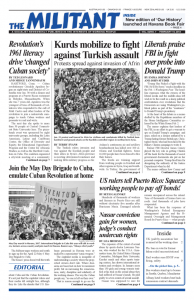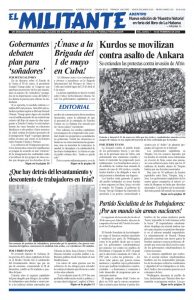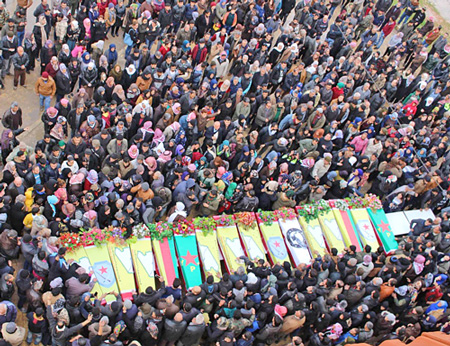The Turkish rulers invasion and war against the Kurdish people and their allies in Syria’s Afrin province is meeting determined resistance and making little military progress so far. Ankara’s continuous air and artillery bombardment has killed over 100 civilians and Kurdish fighters. Some 16,000 people have been forced to flee their homes.
The Kurds are winning support from working people in Kurdish and other regions in Syria, Iraq and worldwide. In Turkey, the government of Recep Tayyip Erdogan has clamped down on opposition to his war, jailing hundreds for the “crime” of raising questions about it on the internet.
Turkey’s capitalist rulers see the gains made by Kurds in developing autonomous areas in northern Syria as a threat to their efforts to prevent the 15 million Kurds inside Turkey from fighting for their national rights.
There are more than 30 million Kurds divided among Syria, Turkey, Iraq and Iran. The capitalist rulers of the four countries share a common interest in pushing back the Kurdish national struggle. The Kurds are the largest nationality in the world without their own state.
Erdogan insists the Turkish rulers will take Afrin and then march across northern Syria until the Kurds are cleared away from the areas close to the border with Turkey up to Iraq. His government demands that Washington withdraw its troops from Manbij, 60 miles east of Afrin and Erdogan’s next target.
Washington has said it has nothing to do with Kurdish People’s Protection Units (YPG) fighters in Afrin, and refuses to do anything to get in the way of the Turkish government’s assault. They just ask Erdogan to make it quick.
But in Manbij, and the large swath of Syria from Deir el-Zour, Tabqa and Raqqa to the Iraqi border — where the Kurdish-led Syrian Democratic Forces has been decisive in defeating and driving out the reactionary Islamic State — the U.S. rulers have built bases, stationed over 2,000 troops and plan to stay. They say they want to prevent any instability that can lead to a resurgence of IS, but their central goal is to block any further advances by the cleric-led Iranian regime.
Washington seeks to push back Tehran’s rising influence without deploying substantial numbers of U.S. troops in Syria.
Just south of Afrin, Iranian-backed militias and Russian air forces are backing an intensified offensive by the Syrian regime of Bashar al-Assad to retake the densely populated Idlib province, controlled by Syrian opposition forces, including Free Syrian Army units and Hayat Tahrir al-Sham, formerly the al-Qaeda affiliate there.
Idlib’s population has swelled by an estimated 270,000 in the past month as people have fled there from other parts of the country, retaken by the Syrian government and its allies.
The Free Syrian Army originated among units of Assad’s army that broke with the regime as it moved to drown in blood the popular protests that broke out in 2011 demanding an end to Assad’s rule. The Turkish rulers gave refuge to these forces, trained and backed them, but their alliance with other rebel forces failed to overthrow Assad. Moscow intervened and the Iranian rulers stepped up their use of ground troops alongside Tehran-backed Hezbollah and other Shiite militia forces to fight for Assad.
The rulers in Iran were among the big winners in Syria, carving out a land bridge from Iran through Iraq and Syria to Lebanon to expand their counterrevolutionary reach. But Tehran’s wars have fueled widespread working-class unrest across Iran.
Disaster for working people
The Assad regime’s bloody attempt to hold on to dictatorial rule and efforts by various capitalist regimes to reinforce their position have been devastating for working people in Syria. Some half a million people have been killed in the civil war and 13 million, more than half the population, forced from their homes.
Working people elsewhere in the region — most sharply in Yemen — also face disaster from the conflicts between Tehran and its central rival the Saudi monarchy.
The rulers in Saudi Arabia continue to enforce a partial blockade of Yemen, restricting the import of food and fuel while some 8.4 million Yemenis are on the brink of starvation. Over a million people are believed to have cholera and half the country’s health care facilities no longer function.
Riyadh aims to push back Shiite Muslim Houthis, who are backed by the Iranian regime. The Saudi rulers’ conflict with the Iranian rulers also fuels their push to remove some of the tribal-based social and political relations that are a hurdle to capitalist “modernization” at home. Without this, they have no chance of taking on Tehran.
In the course of a three-year civil war between contending capitalist forces in Yemen, the Saudi-led military alliance has launched thousands of airstrikes against areas controlled by the Houthis, who seized Sana’a, the capital, in 2015. Houthi leaders, with the patronage of Iran’s capitalist rulers, now control large parts of northwestern Yemen.
The Saudi rulers aim to bolster forces loyal to U.S.-backed President Abed Rabbo Mansour Hadi, who now resides in Saudi Arabia.
Under both the Barack Obama and Donald Trump administrations Washington has provided bombs, intelligence and support to the Saudi-led coalition. On Jan. 30 fissures deepened within the alliance. Forces supported by the United Arab Emirates battled their former partners and seized control of the city of Aden and are now pressing for a revival of the formerly independent country of South Yemen from which to organize their rule.


